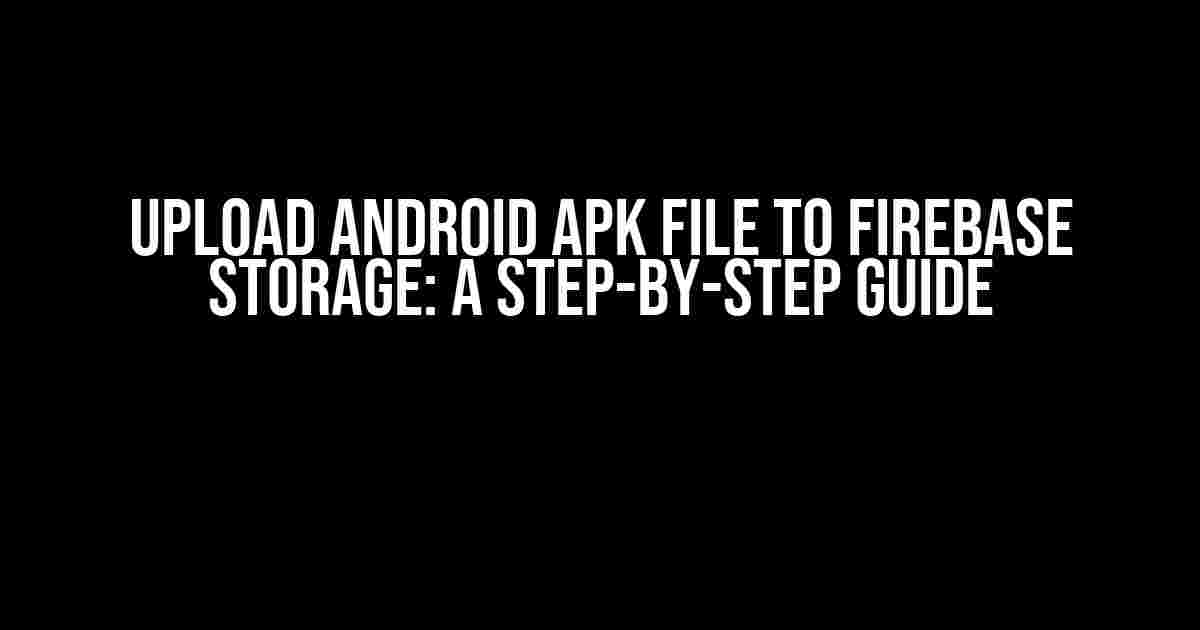Are you tired of dealing with tedious APK file management? Look no further! In this article, we’ll show you how to upload your Android APK file to Firebase Storage, making it easily accessible and manageable. Firebase Storage provides a scalable and secure way to store and serve your APK files, and we’ll guide you through the process with clear instructions and explanations.
- Why Choose Firebase Storage for APK File Management?
- Prerequisites
- Step 1: Create a Firebase Storage Bucket
- Step 2: Install the Firebase CLI and Initialize Your Project
- Step 3: Authenticate with Firebase using the CLI
- Step 4: Upload Your APK File to Firebase Storage
- Step 5: Verify Your APK File Upload
- Conclusion
Why Choose Firebase Storage for APK File Management?
Firebase Storage offers a range of benefits that make it an ideal choice for managing your APK files:
- Scalability**: Firebase Storage scales with your app, handling large files and high traffic with ease.
- Security**: Firebase Storage provides robust security features, including encryption, access controls, and secure upload and download mechanisms.
- Cost-effective**: Firebase Storage offers competitive pricing, with free storage and bandwidth limits for small to medium-sized projects.
Prerequisites
Before we dive into the upload process, make sure you have the following:
- A Google Cloud account (create one here)
- A Firebase project (create one here)
- The Firebase CLI installed on your machine (install instructions)
- An Android APK file ready for upload
Step 1: Create a Firebase Storage Bucket
Login to your Firebase console and navigate to the Storage section:
firebase console -> Storage -> Create BucketChoose a unique name for your bucket, select a location, and set the default storage class:
| Bucket Name | Location | Default Storage Class |
|---|---|---|
my-apk-bucket |
us-central1 |
Standard |
Click “Create Bucket” to create your new storage bucket.
Step 2: Install the Firebase CLI and Initialize Your Project
Open your terminal or command prompt and navigate to your project directory. Run the following command to initialize your Firebase project:
firebase initFollow the prompts to select your Firebase project, and then choose “Storage” as the feature to initialize.
Step 3: Authenticate with Firebase using the CLI
Run the following command to authenticate with Firebase using the CLI:
firebase loginThis will open a browser window to authenticate with your Google account. Grant the necessary permissions, and you’ll be redirected back to your terminal.
Step 4: Upload Your APK File to Firebase Storage
Use the following command to upload your APK file to Firebase Storage:
firebase storage:upload apk-file.apk gs://my-apk-bucket/apk-file.apkReplace apk-file.apk with the name of your APK file, and my-apk-bucket with the name of your Firebase Storage bucket. You can also specify additional options, such as:
-mto specify the MIME type (e.g.,-m application/vnd.android.package-archive)-cto specify the content type (e.g.,-c application/octet-stream)
For example:
firebase storage:upload -m application/vnd.android.package-archive -c application/octet-stream apk-file.apk gs://my-apk-bucket/apk-file.apkThe upload process may take a few minutes depending on the size of your APK file and your internet connection.
Step 5: Verify Your APK File Upload
Navigate to your Firebase Storage console to verify that your APK file has been uploaded successfully:
firebase console -> Storage -> my-apk-bucket -> apk-file.apkYou should see your APK file listed in the bucket, along with its upload date, size, and other metadata.
Conclusion
That’s it! You’ve successfully uploaded your Android APK file to Firebase Storage. With Firebase Storage, you can easily manage and serve your APK files, and take advantage of its scalability, security, and cost-effectiveness. Remember to update your app’s APK file management to utilize Firebase Storage for a seamless and efficient experience.
If you encounter any issues during the upload process, refer to the Firebase Storage documentation for troubleshooting tips and detailed guides.
What’s Next?
Now that you’ve uploaded your APK file to Firebase Storage, you can:
- Integrate Firebase Storage with your Android app to download and install the APK file dynamically
- Use Firebase Cloud Messaging (FCM) to notify users about new APK file updates
- Implement versioning and rollout strategies for your APK file using Firebase App Distribution
Stay tuned for more articles on Firebase and Android development, and don’t hesitate to reach out if you have any questions or need further assistance!
Frequently Asked Question
Get answers to your burning questions about uploading Android APK files to Firebase Storage!
What is the best way to upload an Android APK file to Firebase Storage?
You can upload an Android APK file to Firebase Storage using the Firebase CLI or the Firebase SDK for Cloud Storage. The Firebase CLI provides a simple command-line interface for uploading files, while the Firebase SDK for Cloud Storage provides a programmatic way to upload files from your Android app.
Do I need to create a Firebase project before uploading my APK file to Firebase Storage?
Yes, you need to create a Firebase project and enable the Cloud Storage service before you can upload your APK file. This will provide you with a unique storage bucket where you can store and manage your files.
How do I generate a download URL for my uploaded APK file in Firebase Storage?
You can generate a download URL for your uploaded APK file using the Firebase SDK for Cloud Storage. Simply use the `getDownloadUrl()` method to retrieve a publicly accessible URL that can be used to download the file.
Can I upload multiple APK files to Firebase Storage at once?
Yes, you can upload multiple APK files to Firebase Storage at once using the Firebase CLI or the Firebase SDK for Cloud Storage. You can use the `uploadBytes()` method to upload multiple files in a single operation.
How do I manage permissions and access control for my uploaded APK file in Firebase Storage?
You can manage permissions and access control for your uploaded APK file using Firebase Storage’s built-in security features, such as Identity and Access Management (IAM) and Cloud Storage buckets. You can set permissions and access controls at the bucket, folder, or file level to control who can upload, download, or manage your files.


